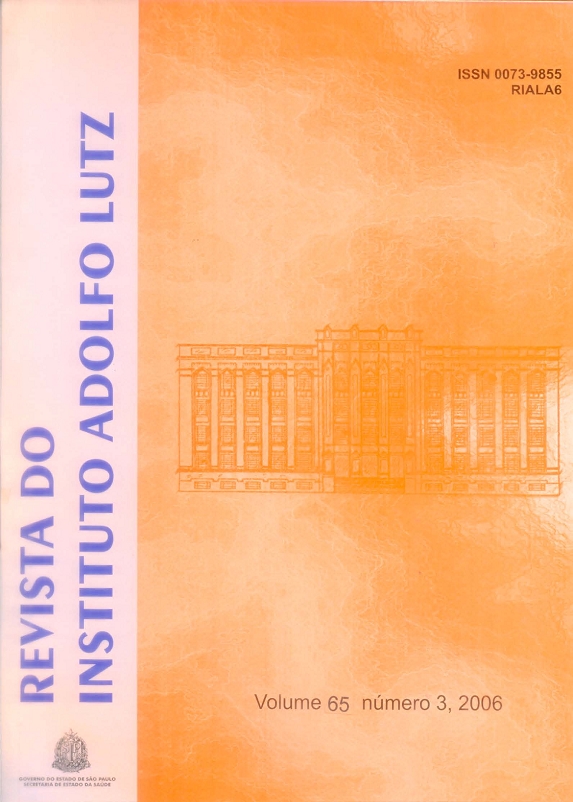Resumen
Além da intoxicação aguda, os organofosforados podem ser responsáveis por outras situações mórbidas a médio e longo prazo. Não foram descritos até o momento os efeitos a longo prazo no sistema cardio circulatóriodecorrentes da exposição prolongada aos organofosforados. Foi nosso objetivo estudar alguns desses possíveis efeitos por métodos histológicos e morfométricos no coração de ratos tratados semanalmente por 12 semanas com doses sub-letais (menos do que 1/3- grupo G5- ou 1/6- grupo G2, 5-da DL50) do organofosforado metamidofós. Foi observado o aumento no peso do coração e hipertrofia de fibras musculares cardíacas nos animais tratados; a média do menor diâmetro dos miócitos cardíacos dos animais controle foi de 64,93 + 5,82 micra e nos tratados foi respectivamente de 82,24 + 12,39 (G2,5) e 88,88 + 10,19 (G5), havendo diferença estatisticamente significativa entre os grupos controle e cada um dos grupos tratados. Sabe-se que a hipertrofia muscular esquerda é um dos principais fatores associados à disfunção cardiovascular. Embora não tenha sido estudado a função cardiovascular, é possível que a exposição experimental mais prolongada a organofosforados possa causar insuficiência cardíaca. Este fato tem uma importância maior no contexto de que a exposição inadvertida e prolongada a esses compostos seja comum em alguns países, incluindo o Brasil.Citas
1. Gordon CJ, Padnos BK. Prolonged elevation in blood pressurein the unrestrained rat exposed to chlorpyrifos. Toxicology.2000; 146(1): 1–13.
2. Cavanagh JB. The toxic effects of tri-ortho-cresyl phosphateon nervous system; an experimental study in hens. J NeurolNeurosurg Psychiatr. 1954; 17:163-72.
3. Sprague GL, Bickford AA. Effect of multipledi isopropylfluorophosphate injections in hens: a behavioral biochemical and histological investigation. J Toxicol EnvironHealth. 1981; 8 (5-6): 973-88.
4. Johnson MK. Organophosphates and delayed neuropathy -Its NTE alive and well? Toxicol Appl Pharmacol. 1990;102(3):385-99.
5. Lotti M. The pathogenesis of organophosphate polyneuropathy.Crit. Rev Toxicol.1992 1; 21(6):465-87.
6. Rosenstock L, Keifer M, Daniell WE, mc Monnell R, Claypoole K. The Pesticide Health Effects Study Group. Chronic central nervous system effects of acute organophosphate pesticide intoxication. Lancet. 1991;(8761)338:223-37.
7. Levin HS, Rodnitzky RL. Behavioral effects of organophosphate in man. Clin Toxicol, 1976; 9(3): 391-403.
8. Kamiya H, Okumura K, Ito M, Saburi Y, Tomida T, HayashiK, Matsui H, Hayakawa T. Calcineurin inhibitor attenuates cardiac hypertrophy due to energy metabolic disorder. Can JCardiol. 2001; 17(12): 1292-8.
9. Socko R, Gralewicz S, Gorny R. Long-term behavioral effects of a repeated exposure to chlorphenvinphos in rats. Int Occup Med Environ Heath. 1999:12: (2): 105-17.
10. Etri MM, Nickell WT, Ennis M, Skau K, Shipley MT. Brainnor epinephrine reductions in soman-intoxicated rats: associationwith convulsions and Ache inhibition, time course, and relationto other monoamines. Exp Neurol. 1992; 118(2): 153-63.
11. Britt, JO, Martin JL, Okerberg CV, Dick EJJr. Histopathologic changes in the brain, heart and skeletal muscle of RhesusMacaques, tem days after exposure to soman norgganophosphorus nerve agent. Comp Med. 2000; 50(2): 133-9.
12. Kassa J, Koupilová M, Herink J, Vachek J. Long- terminfluence of low-level sarin exposure on behavioral and neurophysiological functions in rats. Acta Medica. 2001; 44(1):21-7.
13. Ellman GL, Coutney KD, Andres VJr. Feather-Stone RM. Anew rapid colorimetric determination of acethylcholinesterase activity. Biochem Pharmacol. 1961;7:88-95.
14. Wilheim K. Determination of human plasma cholinesterase activity by adapted Ellman method. Arh Hig Rad Tokskol.1967; 19:199-207.
15. Saadeh AM, Farsakh NA, al-Ali MK. Cardiac manifestations of acute carbamate and organophosphate poisoning. Heart.1997; 77(5): 461-4.
16. Smith EC, Padnos B, Gordon CJ. Peripheral versus centralmuscarinic effects on blood pressure, cardiac contractility, heartrate, and body temperature in the rat monitored byradiotelemetry. Pharmacol Toxicol. 2001;89(1):35- 42.
17. Yen DH, Yen JC, Len WB, Wang LM, Lee CH, Chan SH.Spectral changes in systemic arterial pressure signals during acutemevinphos intoxication in the rat. Shock. 2001; 15(1): 35-41.
18. Kamiya H, Okumura K, Ito M, Saburi Y, Tomida T, HayashiK, Matsui H, Hayakawa T. Calcineurin inhibitor attenuates cardiac hypertrophy due to energy metabolic disorder. Can JCardiol. 2001; 17(12): 1292-8.
19. Sangaralingham SJ, Pak BJ, Tse MY, Angelis E, Adams MA, Smallegange C, Pang SC. Expression of the translational repressor NAT1 in experimental models of cardiachy pertrophy. Mol Cell Biochem. , 2003; 245 (1-2): 183-90.
20. Freed DH, Moon MC, Borowiec AM, Jones SC, Zahradka P, Dixon IM. Cardiotrophin-1: expression inexperimental myocardial infarction and potential role inpost-MI wound healing. Mol Cell Biochem. 2003; 254(1-2): 247-56.

Esta obra está bajo una licencia internacional Creative Commons Atribución 4.0.
Derechos de autor 2006 Revista del Instituto Adolfo Lutz
